Recent trends indicate that Samsung may be relying on Apple to drive innovation in the smartphone market rather than leading with its own advancements. This shift raises questions about the future of Samsung’s product offerings, particularly as competition intensifies within the smartphone industry.
Abdullah, a technology enthusiast, observes that Samsung’s approach to innovation appears reactive, primarily responding to Apple’s moves rather than proactively developing new technologies. The release of the Galaxy Z Fold 7 demonstrates Samsung’s ability to create high-quality devices, but the company’s momentum seems contingent on market pressures.
Samsung’s Innovation Strategy
Samsung has historically been a leader in smartphone technology, yet recent developments suggest a change in strategy. The company has often lagged behind its competitors, particularly when it comes to foldable devices. However, the Galaxy Z Fold 7 exemplifies a significant leap in functionality and design. This shift coincided with increasing competition from Chinese manufacturers and the looming threat of Apple’s anticipated foldable iPhone.
The introduction of the Galaxy G Fold, a tri-foldable smartphone, reflects Samsung’s need to innovate. This move comes in response to competitive pressures, particularly from Apple. By launching new devices shortly after news of similar products from Apple, Samsung appears to be prioritizing its competitive position over independent innovation.
The Impact of Competitive Forces
The smartphone market has become increasingly competitive, with companies like Apple and various Chinese brands pushing the boundaries of technology. Samsung’s reliance on Apple as a catalyst for innovation raises concerns about the company’s long-term strategy. Abdullah notes that Samsung seems to be adopting features from Apple, such as the Now Bar, which mirrors Apple’s Dynamic Island. This trend could lead to a perception that Samsung is lacking originality.
Despite these challenges, Samsung maintains a strong product lineup. The Galaxy Tab S11 Ultra, for example, continues to attract consumers with its high-quality features and performance, even being sold at substantial discounts during promotional periods. However, the cancellation of the Galaxy Edge series raises questions about the future direction of Samsung’s flagship offerings.
As the competition intensifies, especially with the anticipated releases from Apple and ongoing developments from Chinese manufacturers, Samsung’s innovation strategy will be put to the test. The company faces the challenge of not only maintaining its market share but also ensuring that its products stand out in a crowded marketplace.
In conclusion, while Samsung has demonstrated its capability to produce innovative devices, the question remains whether the company will lead the charge or continue to follow in Apple’s footsteps. The future of Samsung’s product lineup may depend significantly on its ability to innovate independently, rather than waiting for a response to its competitors. The smartphone landscape is evolving rapidly, and Samsung will need to adapt to remain relevant in this competitive environment.
